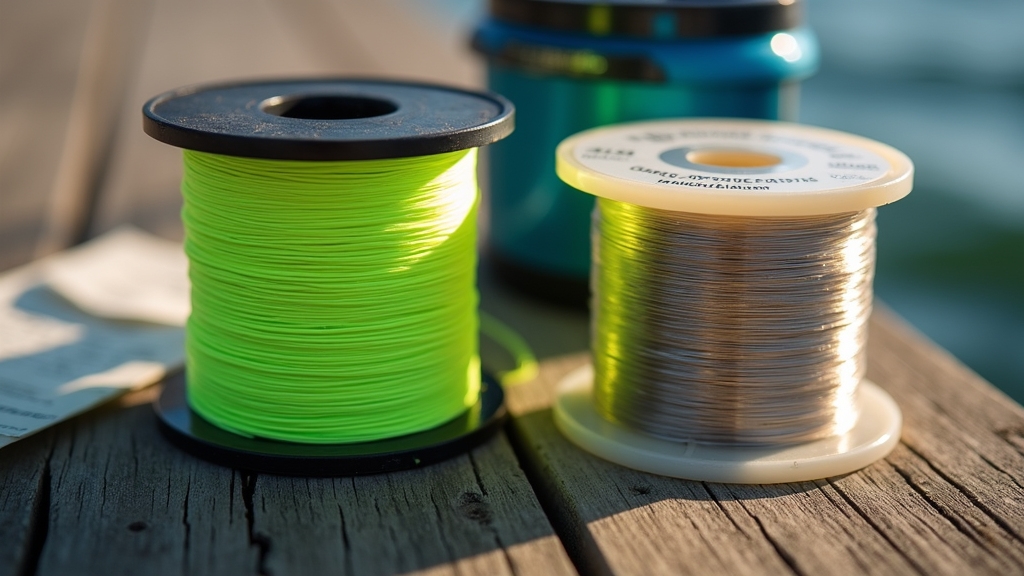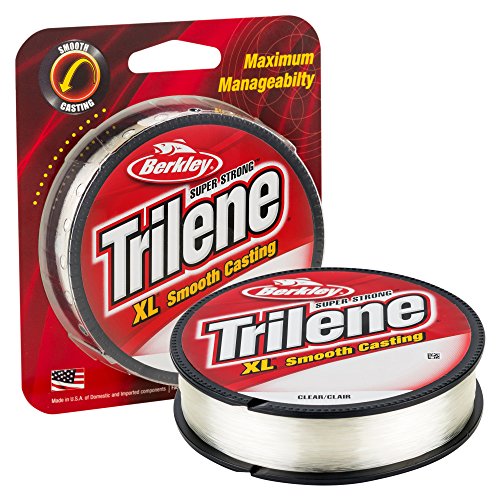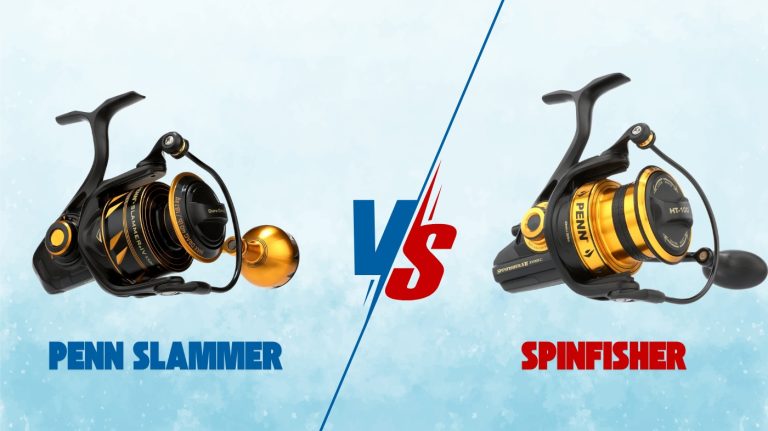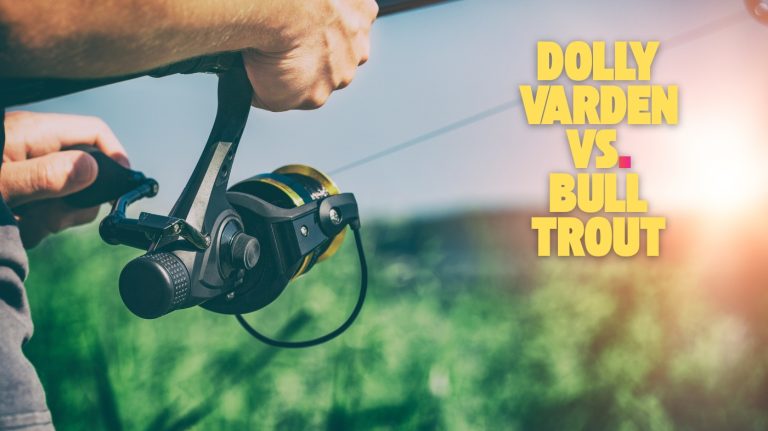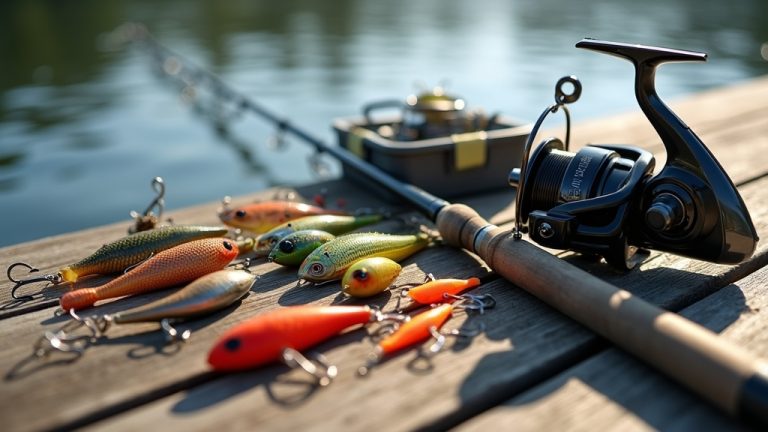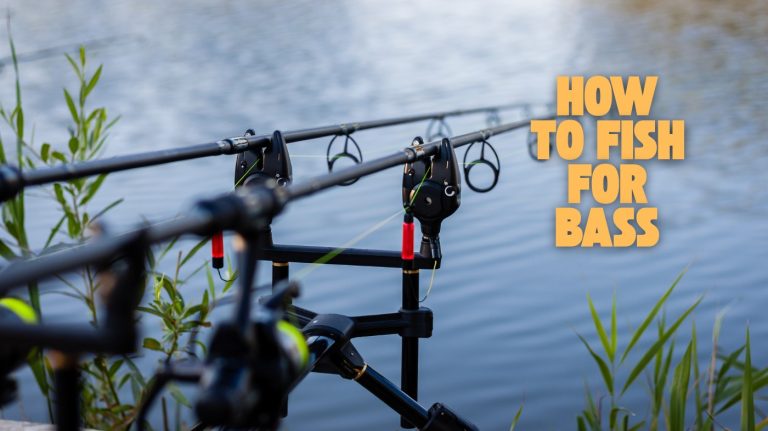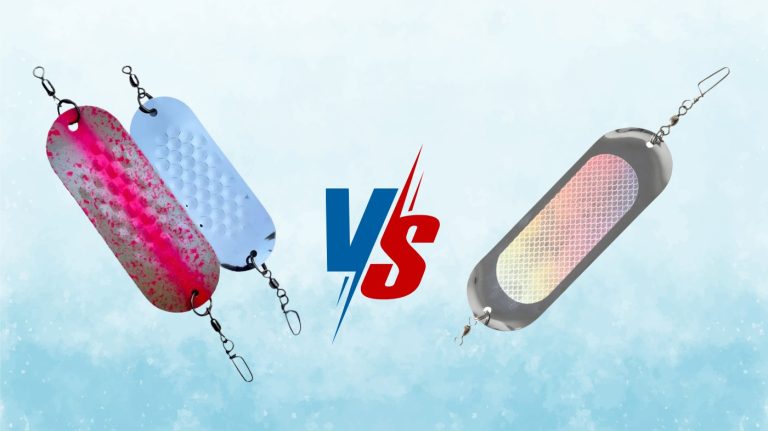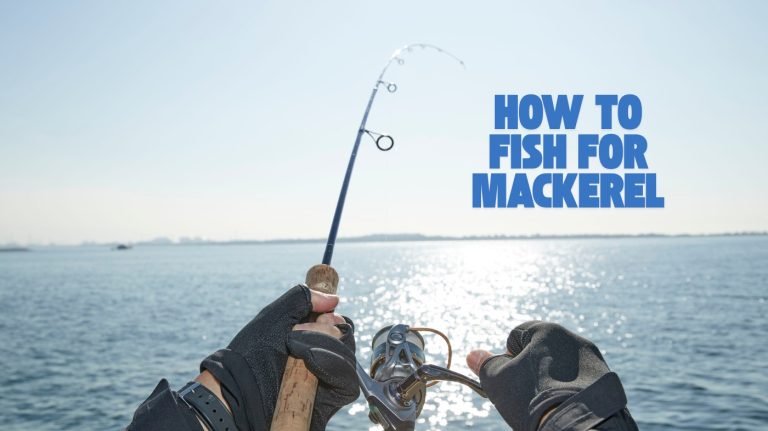Difference Between Braid and Mono Fishing Line: Best Choice
You’ll find braided line made from woven UHMWPE fibers offers superior strength, minimal stretch, and excellent abrasion resistance, allowing thinner diameters for better sensitivity and longer casts.
Monofilament, made from nylon, has more stretch (25–30%), floats or suspends near the surface, and is easier to handle with simpler knots.
Though it’s less durable and absorbs water, understanding their distinct buoyancy, visibility, and knot requirements can markedly enhance your fishing strategy. Exploring these differences will further refine your line choice.
- Strong knot strength – dynamically incorporated strands in KastKing Superpower braided lines allow…
- Low memory – helps you achieve a better, farther casts, less chance of wind Knots
- Greater abrasion resistance – of KastKing braided fishing line decreases the likelihood of losing…
- BERKLEY TRILENE BIG GAME: Don’t let fish off the hook. This heavy duty fishing line was designed to…
- EXTREME FIGHTING POWER: This mono fishing line utilizes a custom blended formula that provides…
- HIGH STRENGTH PER DIAMETER MONOFILAMENT FISHING LINE: This durable line offers a break strength of…
Key Takeaways
- Braid is stronger and thinner than mono, offering high sensitivity with minimal stretch, while mono provides moderate strength and significant stretch for shock absorption.
- Mono is translucent and floats, making it less visible underwater and better for clear water; braid is more visible, denser, and sinks faster for better lure control.
- Braid has superior abrasion resistance and durability, lasting longer despite higher initial cost, whereas mono degrades faster but is more budget-friendly for casual anglers.
- Braid requires specific knots like Palomar or Uni for strength retention, while mono is easier to knot and handle, ideal for beginners.
- Thinner braid lines improve casting distance, lure action, and depth penetration, whereas mono’s thicker diameter can reduce stealth and sensitivity.
Composition and Material Differences Between Braid and Mono
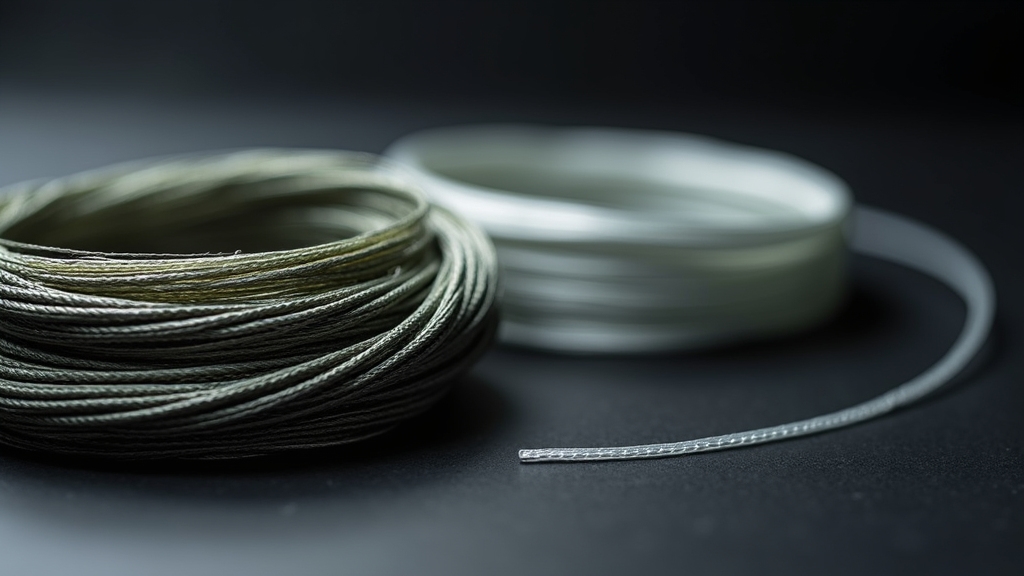
Although both braid and monofilament fishing lines serve the same fundamental purpose, they differ considerably in composition and material properties.
Monofilament is primarily made from nylon, a synthetic polyamide polymer, extruded into a single, smooth strand. It’s less dense than water, causing it to float, and absorbs water over time, impacting performance.
Monofilament lines offer good knot strength, are supple, and have some stretch, which can be beneficial for certain fishing techniques. Its buoyancy makes it especially useful for surface fishing and applications where line visibility is a factor.
Monofilament, crafted from nylon, floats due to low density and absorbs water, affecting its fishing performance.
In contrast, braided lines are woven from ultra-high molecular weight polyethylene (UHMWPE) fibers such as Spectra or Dyneema. These fibers are tightly braided into multiple strands, commonly 4 to 16, to optimize strength and diameter. Braids are often favored for their superior durability and resistance, making them suitable for demanding fishing conditions.
Braids are denser and heavier but maintain a thinner profile, sink faster, and resist water absorption. Braided lines also exhibit superior UV resistance and durability compared to nylon monofilament, which degrades more rapidly under environmental exposure.
Strength and Stretch Characteristics of Braid Vs Mono
When comparing braided and monofilament fishing lines, their strength and stretch characteristics markedly influence performance and application.
Braided line boasts 2.5 to 3 times the strength of mono at equal diameters, allowing you to use lighter line for the same breaking strength.
Its minimal stretch enhances sensitivity and hook-setting power but demands careful pound-test selection to avoid shock breakage. Additionally, braid is made from high-density polyethylene fibers that are up to 15 times stronger than steel by weight, contributing to its exceptional strength and thin diameter (high-density polyethylene).
Monofilament stretches considerably, absorbing shocks and reducing breakage risk, yet it compromises bite detection and hook-set efficiency. This stretch characteristic makes monofilament useful in applications where abrasion resistance and shock absorption are priorities.
| Characteristic | Braided Line | Monofilament Line |
|---|---|---|
| Strength | 2.5–3× stronger per diameter | Lower, requires thicker line |
| Stretch | Minimal (0–5%) | Significant (15–30%) |
| Sensitivity | High | Moderate |
| Shock Absorption | Low | High |
| Hook-Setting Power | Superior | Reduced |
Abrasion Resistance and Durability Comparison
Because braided fishing line consists of tightly woven fibers, it exhibits higher abrasion resistance than monofilament, especially in environments with rocks, submerged logs, and dense vegetation. This makes braid ideal for tough cover, but keep in mind its abrasion resistance varies with context and load. Consider these points:
- Braided fibers resist wear better against sharp or rough surfaces, maintaining strength longer under repeated abrasion.
- Monofilament offers moderate abrasion resistance but degrades faster from friction and UV exposure.
- Mono’s elasticity absorbs shocks, indirectly reducing line damage during sudden impacts.
- Braided line’s durability extends its usable lifespan in harsh conditions, though visual fiber wear demands close inspection. Many braided lines, such as PowerPro and Spiderwire, are engineered with synthetic fibers designed for exceptional strength and abrasion resistance.
Additionally, braid provides an exceptionally high strength-to-diameter ratio, allowing anglers to use thinner lines without compromising strength. Ultimately, braid balances abrasion resistance and strength for heavy cover, while mono suits finesse fishing with better shock absorption.
Visibility and Water Interaction of Fishing Lines
When you’re picking between braid and monofilament, it’s important to think about how each line’s visibility underwater can affect your chances of catching fish.
You see, braid has this woven texture and comes in various colors, which can make it more visible, especially in clear water. The choice of color can also impact stealth, since some anglers prefer lines that blend with the environment, such as green lines in murky conditions.
On the other hand, monofilament floats a bit, and this buoyancy can really change how it interacts with light near the water’s surface. Additionally, monofilament offers 25-30% stretch, which helps absorb shocks and makes it easier to handle during fights.
So, understanding how these lines behave in water is key. It can really help you tweak your rig depending on the conditions you’re fishing in. Whether the water is clear or murky, knowing the differences can give you that edge you need out there.
Underwater Line Visibility
Although braided and monofilament fishing lines serve similar purposes, their underwater visibility differs markedly due to material properties and environmental factors.
You’ll notice braid is notably more visible, especially in clear water and bright light, while mono and fluorocarteron remain nearly invisible under comparable conditions.
Color choice and water clarity also play vital roles in detection by fish. Additionally, the effectiveness of line visibility can be influenced by light conditions, similar to how lens tints affect fishing visibility.
Consider these key points:
- White and blue braid blend better underwater; green, red, and orange stand out sharply.
- Mono and fluorocarbon lines show minimal visibility changes with water clarity.
- Bright sunlight enhances braid visibility, particularly in shaded areas.
- Murky water reduces braid visibility, diminishing its contrast advantage.
In addition, visibility differences in shade mean that all line types become more distinguishable when fishing under cover or near structure. Understanding these nuances helps you select the right line for your fishing environment.
Line Buoyancy Effects
Braided lines are neutrally or slightly positively buoyant, so they tend to stay near the surface or midwater. This reduces snag risks and improves lure control. Their design and material composition contribute to this buoyancy, making them suitable for various fishing conditions.
Monofilament floats more readily, often remaining on or just below the surface. This enhances visibility but increases exposure to surface disturbances like ripples and wind. The lens technology used in fishing sunglasses can help you better see these surface effects and adjust your tactics accordingly.
This buoyancy difference impacts how the line interacts with currents and wave action, affecting drift and presentation precision. Lines that are neutrally buoyant tend to reduce the line’s presence in the water column, which can minimize interference with water flow and reduce the chance of entanglement with underwater obstacles reduces water column presence.
Monofilament’s positive buoyancy allows faster off-reel release, aiding certain casting techniques. Meanwhile, braided’s neutral buoyancy reduces drag and sag in water.
Additionally, floating lines create more surface tension, influencing light refraction and visual detectability to both you and fish. This can alter bite detection sensitivity during your fishing session.
Water Interaction Differences
Buoyancy shapes how your fishing line moves through water, but visibility and line behavior underwater play equally significant roles in your fishing success. Angling, as a hook-centric technique, highlights the importance of precise equipment choices, including the type of fishing line used.
When choosing between braid and mono, consider these factors:
- Mono’s translucency and light refraction make it less visible underwater, ideal for clear water and wary fish. Braid’s woven fibers create a thicker, more visible profile. Additionally, mono is made from a single fiber of plastic called monofilament, which contributes to its subtle visibility.
- Mono floats or suspends near the surface, enhancing lure action with its buoyancy and stretch, which absorbs sudden strikes. This buoyant behavior aligns with the traditional hook-based fishing techniques emphasized in angling.
- Braided line sinks faster due to density, offering better current penetration and sensitivity but transmits more vibration and lacks stretch. Its virtually no stretch property allows for quick hooksets and high sensitivity.
- Braid resists water absorption and UV degradation better, maintaining consistent diameter and performance over time compared to mono. It is constructed from many fibers of man-made materials such as Dacron, Spectra, Dyneema, or UHMPE, which contribute to its durability.
Understanding these water interaction differences helps you optimize line choice for specific fishing conditions.
Knot Strength and Handling Tips for Braid and Mono
When tying knots with braided and monofilament lines, understanding their distinct material properties is essential to maximizing knot strength and durability.
Braided lines, with minimal stretch, require knots like Palomar, Uni, or FG to maintain 80%-100% of line strength. Wetting the line before tightening reduces heat and friction damage. In tests comparing Palomar and Uni knots tied with braid, the Uni knot showed about 8% higher breaking strength, making it the preferred choice for braid knot strength.
You’ll need more wraps for braid to prevent slippage and may apply adhesive for added security. After use, proper cleaning methods can help maintain braid performance and longevity, especially avoiding heat and harsh chemicals that could weaken the fibers.
Monofilament, being more elastic, absorbs shock but suffers from knot slippage and compression. Simpler knots like Improved Clinch or Palomar work best, retaining less knot strength overall. Always wet mono knots too, but they’re less sensitive to friction.
Proper care such as gentle hand washing with mild detergent can help preserve the elasticity and overall condition of monofilament lines. Regularly inspect knots, ensuring consistent tightness to avoid failure, particularly under bending or sliding loads unique to each line type.
Cost Differences and Budget Considerations
You might notice that braided lines tend to have a higher upfront cost compared to monofilament. But here’s the thing: their durability and thinner diameter can actually offer greater long-term value.
For example, braided lines often have a long life span due to their UV resistance and wear durability, making them last multiple seasons. So, if you’re willing to invest a little more initially, you might end up saving in the long run.
On the other hand, monofilament is definitely the budget-friendly option. It’s great for casual anglers because it comes with a lower initial price and is easier to handle. However, monofilament line typically requires annual replacement to maintain optimal strength and reliability.
If you’re just starting out or not fishing that often, this could be the way to go. In the end, it’s all about balancing price with performance and spool capacity. Take some time to think about what fits your fishing needs best, and you’ll be able to choose the most cost-effective option for you.
Price Comparison
A clear understanding of the price differences between braided and monofilament fishing lines helps you make informed budget decisions. Braided lines typically cost more upfront due to advanced materials like Spectra fibers and intricate manufacturing, while monofilament lines remain budget-friendly for casual use.
Additionally, choosing the right line capacity and type is important, as spinning reels generally support higher line capacities that may influence your line selection and cost.
Consider these key points:
- Braided lines can exceed $100 per 300-meter spool; monofilament usually stays under $50 for similar lengths. High-quality braids like the Tasline Elite demonstrate exceptional strength and durability, justifying their premium price.
- Price variability in braid depends on fiber quality, ply count, and brand; mono pricing varies less, influenced by features like UV resistance.
- Higher initial braid cost often balances out with durability and performance benefits.
- Selecting braid might necessitate compatible gear investments, increasing overall expenses.
Value for Money
Although braided fishing lines come with a higher upfront cost, their superior longevity and sensitivity often deliver better value for money over time compared to monofilament. You’ll find braid resists memory and wear, lasting multiple seasons. In contrast, mono degrades faster and requires frequent replacement.
However, braid’s vulnerability to abrasion and knot slippage can increase costs if not managed properly. Additionally, braid’s negligible stretch enhances hook-setting power, which can improve fishing success and reduce lost catches.
| Factor | Braided Line | Monofilament Line |
|---|---|---|
| Longevity | Multiple seasons, abrasion sensitive | Shorter lifespan, abrasion resistant |
| Sensitivity | High, zero stretch, improves hook setting | Moderate, stretch absorbs shocks |
| Knot Strength | Requires special knots, slick | Easier knots, reliable holding |
| Replacement Cost | Higher upfront, less frequent | Lower upfront, more frequent |
| Usage Context | Best in heavy cover, precise fishing | Better in rough terrain, shock absorption |
Budget-Friendly Options
When selecting fishing line within a budget, understanding the cost differences between braided and monofilament lines is essential. Braided line costs more upfront due to its complex manufacturing, while mono is cheaper and more accessible initially.
However, long-term costs vary based on durability and usage. Consider these budget factors:
- Braided lines last multiple seasons, reducing replacement frequency despite higher initial cost. Additionally, braid offers higher strength-to-diameter ratio, allowing more line on reels which can be cost-effective for deep or long-distance fishing.
- Monofilament requires frequent replacement due to stretching and memory, increasing overall expense.
- Braids spool more line due to thinner diameter, lowering costs for deep or long-distance fishing.
- Mono’s abrasion resistance can reduce line damage costs in rough environments.
Balancing these aspects helps you optimize spending based on fishing style and frequency.
Ideal Usage Scenarios for Braided Fishing Line
Because braided fishing lines offer near-zero stretch and exceptional tensile strength, you’ll find them ideal for techniques demanding high sensitivity and immediate hook sets, such as jigging and topwater fishing. Their minimal stretch provides direct feedback on subtle bites and precise lure action, enhancing your control and strike response.
Braids excel in heavy cover environments, dense weeds, lily pads, and mangroves, where abrasion resistance and strength enable you to muscle large fish out without line failure. Their thin diameter and low water resistance also allow longer, more accurate casts, critical for reaching pressured fish or precise lure placement near structure.
You’ll rely on braided lines when targeting aggressive species requiring heavy tackle, flipping, or punching vegetation, especially when paired with fluorocarbon leaders to balance durability and invisibility in clear water.
Additionally, many braided lines come in various colors to meet visibility needs and fishing environments, allowing anglers to choose the best option for their specific conditions color options.
Best Situations to Use Monofilament Line
When you’re out fishing in clear water, using monofilament line can really give you an edge. Its low visibility means that fish won’t easily spot it, which is great for enhancing your lure presentation. Plus, the natural buoyancy of monofilament helps keep your bait looking lively in the water, reducing the chances of spooking those wary fish.
Another fantastic thing about monofilament is its significant stretch. This stretch acts like a shock absorber, which is super helpful when you’re dealing with sudden strikes or those aggressive runs from powerful fish. It really minimizes the risk of line breakage when you need it most.
Additionally, monofilament’s knot-friendly nature allows anglers to tie strong, reliable knots with ease, ensuring optimal performance on every cast.
Clear Water Advantages
Why should you choose monofilament line for clear water fishing? Monofilament offers key advantages that enhance stealth and presentation in transparent conditions. Consider these factors:
- Low Visibility: Its clear, translucent nature reduces line detection by wary fish. This improves your catch rates compared to more visible braided lines.
- Buoyancy: The line floats, making it ideal for topwater lures like poppers and frogs. This keeps your presentation natural and prevents line sinking that could spook fish. Additionally, monofilament’s high flexibility allows for easy casting and handling, enhancing your overall fishing experience.
- Knot Reliability: Mono’s flexibility allows for stronger, more secure knots. This is vital when precise, dependable gear is needed in clear water setups.
- Cost Efficiency: Affordable and widely available, monofilament lets you frequently replace your line. This maintains excellent performance without breaking your budget.
Shock Absorption Benefits
Monofilament’s low visibility and buoyancy make it a top choice for clear water fishing, but its shock absorption properties are equally valuable in demanding angling situations.
You’ll benefit from mono’s 20-25% stretch, which acts as a natural shock absorber during hard hooksets or explosive fish runs, reducing sudden line breaks.
This elasticity provides a “forgiveness factor,” compensating for drag sticking or stiff gear, and decreasing hook pull-out, especially with aggressive freshwater species like bass or trout.
Mono’s stretch also prevents the hook from tearing through the fish’s mouth, increasing landing success. Additionally, its flexibility improves casting smoothness and line control while protecting knots and tackle by distributing force over time.
When paired with a stiff rod and proper drag settings, monofilament maximizes shock absorption and fish control in intense battles. Its budget-friendly nature also makes it accessible for anglers at all skill levels, offering excellent performance without a high cost.
Combining Braid and Mono for Optimal Fishing Performance
Although braid and mono lines each offer distinct advantages, combining them leverages their complementary properties to enhance overall fishing performance.
By spooling braided line on your reel and attaching a monofilament leader, you balance strength, sensitivity, and stretch for diverse conditions.
Spooling braid with a mono leader blends strength and stretch for versatile fishing performance.
- Use braid as the mainline for its high tensile strength and near-zero stretch, improving hook-setting and long casts.
- Attach a mono leader to absorb shocks and provide abrasion resistance near lures or fish teeth. This combination is especially effective when targeting species known for their acrobatic jumps, such as sailfish, because the shock absorption of mono helps prevent line breakage.
- Mono leaders reduce line visibility underwater, increasing stealth in clear water environments.
- This setup improves knot strength and reduces fish loss during sudden runs, optimizing tackle longevity and bite detection.
Combining these lines lets you exploit braid’s durability and mono’s elasticity, tailoring your rig for both saltwater and freshwater success.
How Line Diameter Affects Fishing Experience?
When you select fishing line diameter, you directly influence casting distance, lure behavior, and fish response. Thinner lines reduce air resistance and spool friction, enabling longer casts and improved water coverage, especially with light lures.
They also minimize water drag, allowing lures to reach their intended depth and maintain natural action essential for triggering strikes.
Conversely, thicker lines increase friction and wind resistance, shortening casts and limiting lure movement. It is important to note that true line strength correlates more closely with diameter than with pound test ratings.
Diameter impacts line visibility underwater; smaller diameters are less detectable, reducing fish spooking. However, strength and abrasion resistance don’t always correlate linearly with diameter—braided lines can be thinner yet stronger than thicker monofilaments.
Selecting the most suitable diameter balances sensitivity, casting efficiency, lure performance, and durability. This ensures precise control and maximizes your fishing success.
Frequently Asked Questions
How Do Temperature Changes Affect Braid and Mono Fishing Lines?
You’ll notice monofilament weakens under heat, becoming brittle and losing tensile strength, especially at knots. Cold makes it stronger but more prone to snapping. UV exposure worsens this degradation.
Braided lines resist heat better, maintaining strength and flexibility, and remain stable in cold. However, extreme heat can soften their coatings. To keep both lines performing well, store them away from intense heat and sunlight. Inspect regularly for damage.
Can Braided Line Damage Fishing Rod Guides More Than Mono?
Think of braided line as sandpaper next to monofilament’s silk. Braid’s woven fibers are rougher and can cause more abrasion on softer rod guides like aluminum oxide.
However, if you use rods with hardened guides such as ceramic or silicon nitride, you’ll find braid doesn’t considerably damage them. Proper spooling, regular inspection, and using leaders help minimize wear.
What Are the Environmental Impacts of Disposing Braid Versus Mono Lines?
When you dispose of braided line, its complex materials prevent recycling, so it usually ends up in landfills. This poses long-term environmental hazards due to slow degradation and wildlife entanglement risks.
Monofilament line, however, is recyclable and can be repurposed, reducing environmental impact.
Both types degrade over centuries and can entangle animals, so cutting lines into small pieces and using recycling programs for mono are essential to minimize harm effectively.
How Does UV Exposure Degrade Braid Compared to Mono Lines?
You’ll find that UV exposure degrades monofilament lines much faster than braided lines. UV light breaks down the nylon polymers in mono, causing brittleness, discoloration, and reduced tensile strength.
Braided lines, made from UV-resistant synthetic fibers like Spectra or Dyneema, maintain strength and elasticity longer. Although braid coatings may fade, the core fibers resist photo-oxidation better.
Are There Specific Reel Types Better Suited for Braid or Mono Lines?
Of course, you’ll want to ignore reel recommendations and just toss any line you like, right?
Well, spinning reels actually favor braid thanks to its thin diameter and zero memory, while baitcasting reels pair well with braid for control and accuracy. Mono suits spinning reels better, offering stretch that absorbs shock and protects your gear.
Buoyancy and Visibility: How Line Type Impacts Your Catch Rate?
You might worry that switching between braid and mono lines complicates your setup, but combining them actually fine-tunes your fishing performance. Braid offers superior strength and sensitivity with minimal stretch, while mono provides better knot security and abrasion resistance.
By understanding their distinct properties and using each where it excels, you optimize casting distance, hook sets, and line durability. This technical balance guarantees you’re always prepared for varying conditions without compromise.
- STRONG: This premium braided fishing line from Reaction Tackle is engineered from ultra high…
- ABRASION RESISTANT: People fishing braided line rigs in situations with logs and rocks know the…
- COLOR SAFE: Say goodbye to fishing braid that quickly loses color over time; This advanced fishing…
- BERKLEY TRILENE XL: Don’t let fish off the hook. Stronger and smoother than ever before, this…
- MAXIMUM MANAGEABILITY: This mono fishing line resists twists and kinks allowing for remarkably…
- HIGH STRENGTH PER DIAMETER MONOFILAMENT FISHING LINE: This easy-casting fish line offers a break…
Last update on 2025-11-29 / Affiliate links / Images from Amazon Product Advertising API

